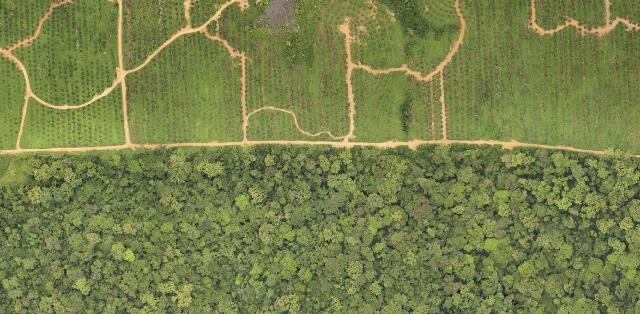Jun 30 2016
The production of oil palms has been expanding from Southeast Asia to Central Africa. In light of this expansion, a new study conducted by Duke University has revealed that conversion of the tropical forests in Africa into monoculture palm plantations can severely affect the emission of climate-warming carbon.
 A palm oil plantation abuts intact forests in Gabon. (Credit: John Poulsen)
A palm oil plantation abuts intact forests in Gabon. (Credit: John Poulsen)
Warning that the conversion will lead to the increase in the carbon emission, the authors of the research have urged the regional authorities to act. They have suggested that the government brings policies in place to regulate the clearing of forests, deciding which forests are to be cleared and which are to be conserved.
Our case study, which focuses on oil palm farming in the nation of Gabon, finds that converting even previously logged forest into oil palm plantations will lead to high carbon emissions. Clearing just 11,500 hectares of forest -- or roughly 28,400 acres -- would release about 1.5 million metric tons of carbon into the atmosphere. That’s equivalent to the annual emissions of some small developing countries.
John R. Poulsen, Assistant Professor of Tropical Ecology, Duke University
The research has also found that these emissions can be fully compensated for a period of over 25 years if developments were made in forests that have low carbon storage and if a segment of every development had set–asides.
The peer-reviewed study, by Poulsen and his fellow researchers, has been published in Conservation Letters on June 24.
The team used data from LiDAR satellite and field measurements to measure the carbon stocks or the amount of carbon stored in the trees of the forest. They also estimated the potential carbon emission of the palm oil plantation in Gabon that is spread across 50,000 hectares. The palm-oil plantation is being created by Olam International Ltd., an agribusiness company and the Gabonese government. The development is done to determine whether it is feasible to develop low-emission palm oil plantations in the equatorial nation located in the Atlantic Ocean.
While Gabon has ambitions of becoming a leading producer of palm oil, it also has made pledges to protect its environment and biodiversity. If this site is successful, it could open the door to development at other sites, so it’s imperative that our work helps the government strike the right balance between economic development and environmental conservation.
John R. Poulsen, Assistant Professor of Tropical Ecology, Duke University
Large-scale production of palm oil in Southeast Asia has created widespread deforestation, loss of biodiversity and a lot of region-wide issues regarding emissions, said Poulsen. The research has suggested a two-phased technique concerning siting and development of plantation, to avoid similar problems from arising in Gabon.
First, we recommend establishing a nationwide carbon threshold of 108 to 118 metric tons per hectare. Only forests that store less than this density of carbon will be considered suitable for development. Second, palm oil companies will also have to set aside enough land within a plantation -- roughly one acre for every 2.6 acres developed -- to offset emissions. The precise set-aside ratio may vary by site, but 2.6 to 1 is generally the point at which carbon storage in the conserved forest will offset carbon loss in the rest of the plantation and achieve net-zero emissions over time. Although our study considers only forest carbon, and not biodiversity or other ecosystem services, we estimate there is enough low-carbon forest in Gabon to achieve net-zero emissions while still permitting the nation to meet its palm oil production goals.
John R. Poulsen, Assistant Professor of Tropical Ecology, Duke University
Poulsen also insisted that allowing the industry to voluntarily hold on to these new guidelines or opt out of them is not an option. “To succeed, this approach needs to be mandatory and implemented by the government with careful land-use planning and strict enforcement.”
The research has been supported by Olam Palm Gabon and Duke’s Nicholas School of the Environment.
The research was conducted by Poulsen along with 2014 Master of Environmental Management graduate of Duke’s Nicholas School, Mark E.H. Burton. The co-authors were Michelle E. Lee, Vincent P. Medjibe and Lee J.T. White of Gabon’s Agence Nationale des Parcs Nationaux, and Christopher G. Stewart and Arun Venkataraman of OLAM International Ltd.